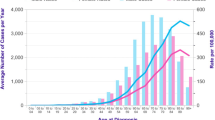Abstract
Colorectal cancer screening guidelines are identical for men and women despite reported differences in epidemiology, endoscopy performance, screening preferences, and screening uptake. High-quality research is needed to determine whether gender aspects may in real world increase acceptance and overcome screening barriers, which may lead to better use of limited resources allocated for public health.
Similar content being viewed by others
References
Papers of particular interest, published recently, have been highlighted as: • Of importance •• Of major importance
Boyle P, Ferlay J. Cancer incidence and mortality in Europe, 2004. Ann Oncol. 2005;16:481–8.
Jemal A, Siegel R, Ward E, et al. Cancer statistics, 2008. CA Cancer J Clin. 2008;58:71–96.
Segnan N, Patnick J, von Karsa L, editors. European Guidelines for quality assurance in colorectal cancer screening and diagnosis. 1st ed. Luxembourg: European Commission, Publications Office of the European Union; 2010.
Brenner H, Hoffmeister M, Arndt V, Haug U. Gender differences in colorectal cancer: implications for age at initiation of screening. Br J Cancer. 2007;96:828–31.
Regula J, Rupinski M, Kraszewska E, et al. Colonoscopy in colorectal-cancer screening for detection of advanced neoplasia. N Engl J Med. 2006;355:1863–72.
•• Ferlitsch M, Reinhart K, Pramhas S et al. Sex-specific prevalence of adenomas, advanced adenomas, and colorectal cancer in individuals undergoing screening colonoscopy. JAMA. 2011;306(12):1352–8. This recently published study shows a difference of about 10 years in prevalence of advanced adenomas between men and women.
• Nguyen SP, Bent S, Chen Y-H, Terdiman JP. Gender as a risk factor for advanced neoplasia and colorectal cancer: a systematic review and meta-analysis. Clin Gastroenterol Hepatol. 2009;7:676–81. This meta-analysis confirms that risk for advanced neoplasia is higher in men.
Hoffmeister M, Schmitz S, Karmrodt E, et al. Male sex and smoking have a larger impact on the prevalence of colorectal neoplasm than family history of colorectal cancer. Clin Gastroenterol Hepatol. 2010;8(10):870–6.
Denis B, Reutsch M, Strentz P, et al. Short term outcomes of the first round of a pilot colorectal cancer screening programme with guaiac based faecal occult blood test. Gut. 2007;56:1579–84.
•• Lansdorp-Vogelaar I, van Ballegooijen M, Zauber AG, et al. Individualizing colonoscopy screening by sex and race. Gastrointest Endosc. 2009;70:96–108. In this study, a micro-simulation model was used to estimate cost-effectiveness of individualizing colonoscopy screening by gender and race.
McCashland TM, Brand R, Lyden E, de Garmo Pat, AP CORI Research Project. Gender differences in colorectal polyps and tumors. Am J Gastroenterol. 2001;96:882–6.
Schoenfeld P, Cash B, Flood A, et al. Colonoscopic screening of average-risk women for colorectal neoplasia. N Engl J Med. 2005;352:2061–8.
Imperiale TF, Wagner DR, Lin CY, et al. Risk of advanced proximal neoplasms in asymptomatic adults according to the distal colorectal findings. N E J Med. 2000;343:169–74.
Rex DK, Cummings OW, Helper DJ, et al. 5-year incidence of adenomas after negative colonoscopy in asymptomatic average-risk persons. Gastroenterology. 1996;111:1178–81.
Brenner H, Haug U, Arndt V, et al. Low risk of colorectal cancer and advanced adenomas more than 10 years after negative colonoscopy. Gastroenterology. 2010;138:870–6.
Stewart BT, Keck JO, Duncan AV, et al. Difficult or incomplete flexible sigmoidoscopy: implications for a screening programme. Aust N Z J Surg. 1999;69:19–21.
Eloubeidi MA, Wallace MB, Desmond R, et al. Female gender and other factors predictive of a limited screening flexible sigmoidoscopy examination for colorectal cancer. Am J Gastroenterol. 2003;98:1634–9.
Adams C, Cardwell C, Cook C, et al. Effect of hysterectomy status on polyp detection rates at screening flexible sigmoidoscopy. Gastrointest Endosc. 2003;57:848–53.
Saunders BP, Fukumoto M, Halligan S, et al. Why is colonoscopy more difficult in women? Gastrointest Endosc. 1996;43:124–6.
Aslinia F, Uradomo L, Steele A, et al. Quality assessment of colonoscopic cecal intubation: an analysis of 6 years of continuous practice at a university hospital. Am J Gastroenterol. 2006;101:721–31.
Hoff G, Bretthauer M, Huppertz-Hauss G, et al. The Norwegian Gastronet project: continuous quality improvement of colonoscopy in 14 Norwegian centres. Scand J Gastroenterol. 2006;41:481–7.
Thiis-Evensen E, Hoff GS, Sauar J, et al. Patient tolerance of colonoscopy without sedation during screening examination for colorectal polyps. Gastrointest Endosc. 2000;52:606–10.
Kim WH, Cho YJ, Park JY, et al. Factors affecting insertion time and patient discomfort during colonoscopy. Gastrointest Endosc. 2000;52:600–5.
Early DS, Saifuddin T, Johnson JC, et al. Patient attitudes toward undergoing colonoscopy without sedation. Am J Gastroenterol. 1999;94:1862–5.
Ko CW, Riffle S, Shapiro JA, et al. Incidence of minor complications and time lost from normal activities after screening or surveillance colonoscopy. Gastrointest Endosc. 2007;65:648–56.
McQueen A, Vernon SW, Meissner HI, et al. Are there gender differences in colorectal cancer test use prevalence and correlates? Cancer Epidemiol Biomarkers Prev. 2006;15:782–91.
Stockwell DH, Woo P, Jacobson BC, et al. Determinants of colorectal cancer screening in women undergoing mammography. Am J Gastroenterol. 2003;98:1875–80.
Farraye FA, Wong M, Hurwitz S, et al. Barriers to endoscopic colorectal cancer screening: are women different from men? Am J Gastroenterol. 2004;99:341–9.
Menees SB, Inadomi JM, Korsnes S, Elta GH. Women patients’ preference for women physicians is a barrier to colon cancer screening. Gastrointest Endosc. 2005;62:219–23.
Fidler H, Hartnett A, Cheng Man K, et al. Sex and familiarity of colonoscopists: patient preferences. Endoscopy. 2000;32:481–2.
Disclosure
No potential conflicts of interest relevant to this article were reported.
Author information
Authors and Affiliations
Corresponding author
Rights and permissions
About this article
Cite this article
Regula, J., Chaber, A. & Kaminski, M.F. Should There Be Gender Differences in the Guidelines for Colorectal Cancer Screening?. Curr Colorectal Cancer Rep 8, 32–35 (2012). https://doi.org/10.1007/s11888-011-0113-2
Published:
Issue Date:
DOI: https://doi.org/10.1007/s11888-011-0113-2




